Can’t find your website on Google? If you aren’t showing up on the first page of Google then you’re missing out on a major traffic and revenue source for your business. To fix this you’ll need to engage in some search engine optimization (SEO). Below you'll find eight important factors and insights from some of the biggest experts in SEO and content marketing today.
1. Your New Website Needs SEO…and Time
I’ve talked to businesses who launch a brand new website with a new domain on Tuesday and wonder on Wednesday why their site doesn’t appear on Google.
Newer sites don’t tend to rank well on Google. You may have to dig deep into Google’s search results to even find your website for a branded search term (the name of your company, key players, the brand name of your products, etc.)
You can’t expect to rank well right out of the gate, especially when your competition may have been producing high-quality content, getting inbound links, and optimizing themselves at the search engines for years.
You wouldn’t expect to play in The Masters right after you bought your first set of clubs, would you?

The first thing you’ll want to do is to see if your website even exists in Google’s index. To do this, go to Google and do a search for “site:yourdomain.com” where yourdomain.com is, well, your domain. Make sure there are no spaces before or after the colon.
If there are no results, “your search – site:yourdomain.com – did not match any documents,” then Google doesn’t know you exist and you’ll never rank…well or poorly. You’ll need to determine why Google hasn’t indexed you. Be sure to check the Crawl Issues section below.

Search Bots don’t crawl and index all web pages in the same way. Javascript-powered websites, for example, command significant resources from Google that often force crawling and indexing to be performed in a two-wave process.
Here's the fallout: the indexation of your latest content marketing efforts could be delayed hours, days, or even weeks!
One solution is to leverage a key Google initiative called dynamic rendering. Dynamic rendering allows you to serve one version of your website optimized for the human experience, and another, stripped-down version optimized for Search Bots to crawl, understand, and index in a timely manner.
The benefits of this initiative are numerous. Search Bots load pages faster and see more content, front-end development stays intact for the user experience, and you can rest assured that your latest published content has entered into Google's index to appear in search results.
If there are results, it means Google is aware your site exists and you can work on improving the overall ranking and visibility of your site. Keep reading….
2. You’ve Got Crawl Problems That Are Hurting Your SEO
Whether your site ranks poorly in Google or not at all, the problem may be due to crawling issues. In short, it’s difficult or impossible for Google to visit, crawl (read), and index (store) your site, you won’t rank.
It may be that you have a technical problem that’s keeping you from ranking. (You got thrown out on a technicality.)
One way to determine if this is a problem is by visiting your Google Search Console. If you’ve never set up your Google Search Console, you can do so by visiting search.google.com/search-console, clicking Start Now, and then logging in with your Google Account credentials.
Once logged in, click “Coverage” in the left hand menu, which will show you all the pages on your site where Google ran into trouble.
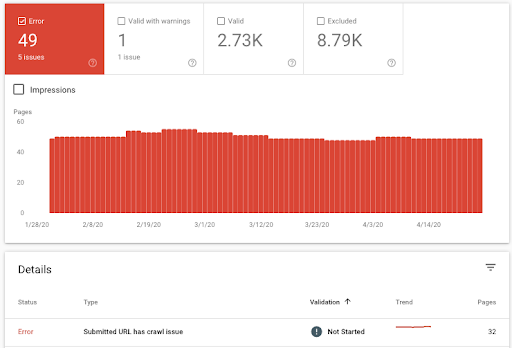
If there are pages listed in the error reports, it means that they won’t appear in Google’s search results. You or your web developer will need to address the problems and fix them.
One problem may be that you have inadvertently blocked key pages from Google’s index with something called a robots.txt file. This is a list of pages that you don’t want Google to crawl and index.
Sometimes, developers hide pages while they’re under development so the unfinished pages don’t get indexed by Google.
Sometimes, they forget to un-hide them. ?
Other times robots.txt files are misconfigured, accidentally hiding entire sections of websites from Google.
You can help Google crawl more of your pages by submitting an XML sitemap…one that’s automatically updated so you don’t have to keep resubmitting it every time you update your website.
If you’re on WordPress, we recommend the Yoast SEO plugin that offers this functionality.
If you really want to nerd out on crawl issues, I recommend checking out Moz’s deep dive here.
Other technical issues that might hurt your search visibility include:
- Your site is not mobile-friendly. Google uses a “mobile first” approach to indexing sites, so sites that aren’t optimized for mobile won’t rank well. To test your own site use Google’s Mobile-Friendly test.
- Your site is slow. If your site is equal in value to a competitor’s site, but your page load-time is low, it can hurt your visibility. You can view your page’s load times in Google Analytics or use this tool by GTMetrix.
- Your site is not secure. Google wants your site to be encrypted, meaning it should start https, not http. Ask your web developer or hosting company for help.

There are generally two good times to verify with Google Search Console; the first is immediately after your site launched, the second is right now.
Think of verifying with Google Search Console like getting the search engine’s cell phone number. Verifying your site with Google Search Console opens up a communications channel with the search engine; you get to tell Google about new content on your site, and the engine will tell you about any problems it finds crawling your site.
3. You’re Not Speaking Your Customer’s Language (Keyword Research)
If you confirmed Google is aware of your website (step 1) and that technical or crawl problems aren’t the issue (step 2), then it’s time to examine whether you’re using the same language as your customers.
Maybe you’re using technical terms but your audience isn’t familiar with the jargon. You’re writing about your vocal stylings while they’re searching for a wedding singer. Or you’ve coined a term that differentiates your business…but no one is searching for that term.
Another problem could be that you’re targeting a keyword that’s too broad, such as travel or coach. Those terms are so broad they open you up to competition from anyone in the travel industry or anyone looking for business, life, or batting coach. Instead, you might do better targeting a narrower niche, such as Maine family adventure travel or leadership coaching for non-profit professionals.
If you’re not sure you’re using the words your customers use at Google, you’ll want to do some keyword research. Keyword research is market research, and it’s a critical component of ranking well at the search engines.
First, brainstorm words and phrases that your ideal customer may use at Google. To help me generate more potential keywords I use five perspectives:
- Products and services (what you bring to market)
- Customer Problems (what you help people overcome)
- Desired Outcomes (what the results are)
- Features (specifics of your offering)
- Competition (what other solutions are there)
If you need some more structure or help around this step, check out how to brainstorm SEO keywords for your website.
Next, you’ll want to test your keywords to discover how often they’re being searched for (search volume) and how much competition they have from other sites.

Choosing the right keywords isn't easy. But it's the key first step of any SEO campaign. In my experience, most people struggle to rank because they choose keywords that are way too competitive. If you want to show up at the top of Google, choosing low competition keywords can really help. Especially for new sites without a lot of backlinks yet.
There’s no point optimizing your site for a phrase no one is searching for, and if you’re going up against a lot of well-entrenched competition, you need to know that to manage your expectations and know if you should “niche down”, like in the example of Maine family adventure travel vs travel.
At flyte, we use a number of agency-level SEO tools that help us uncover the best opportunities for our clients. But if you’re just doing this yourself, or you just need some quick research for a blog post, you can use Google’s Keyword Planner.
Put in a few related keywords:

And Google will return the average monthly searches and the competition for those phrases as well as related phrases that might perform better.
The competition is for paid search, not organic SEO, but there’s usually a lot of overlap.

Here you can see that Google suggests lingual as a good, high volume, low competition search term.
Pro Tip: You’ll need to set up a free account for Google Ads to access the tool. However, Google will give you more detailed information if you’re spending money on ads. So, set up an ad and let it run with a budget of a few dollars a day while you’re doing your research.
Keep in mind that there are a lot of other businesses who may have a head start on you, and are already targeting your best keywords. Sometimes that means going after “mid-funnel keywords.”

The best converting keywords in almost every industry have gotten too competitive to invest time and effort into.
Recently, Google has made matters worse by increasing the number and visibility of the ads on the search results pages. I recommend optimizing for mid-funnel keywords that trigger less advertising but still have purchase intent.
And if you don't have a lot of authority built up at your site (more on that later), consider focusing on longer, less competitive keywords.

Without a lot of links from other websites, your site isn't considered authoritative by Google, so you'll need to target less competitive, less popular phrases. These are usually the longer 4- and 5-word phrases (or even longer). Even low authority sites can rank quickly if they target really long, specific phrases.
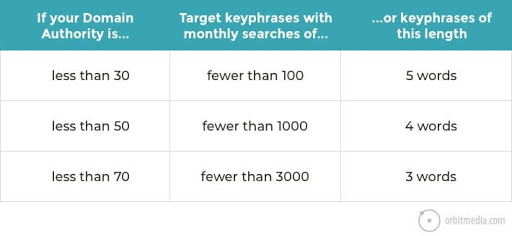
Image source: How to Research Keywords, Orbit Media
4. You Didn’t Optimize Your Site for the Search Engines (Keyword Placement)
Even if you know the keywords people are using, it’s critical to put them in the right places.
Look at every page on your website as an opportunity to get found by your ideal customer when they need you most. Each page should address a specific keyword or group of keywords you’re targeting. Once you know what keywords you’re targeting for a given page or blog post, here’s where you need to put your keywords:
- Title Tag: Just about every SEO expert agrees that this is the most important place to put your keywords. This actually appears outside your webpage, and is also the “big blue link” in Google’s search results.
- Meta Descriptions: Like the title tag, meta descriptions don’t appear on your web page. And many people believe they have little to no direct impact on your search ranking. However, this is what often appears below the big blue link in the search results, so consider this a free classified ad that might get someone to click on your link.
- Headers and Subheads: If you know HTML, these are your H1 – H6 tags (although let’s just use H1 – H3.) These header tags are bigger and bolder than your regular body copy, and they’re what people use as they scan your page. (What, you thought they were reading everything? Only Google does that.)
- Body Copy: The rest of the text. Make sure your keywords appear in the first sentence or two, and then as needed throughout the page. You don’t need to use the exact phrase ad nauseum; Google understands that realtor and real estate agent are related.
- Alt-tags: These tags “hide” behind images, giving Google an idea of what’s in the images on your site. Descriptive, keyword rich alt-tags can help you get found in Google’s image search and can drive more traffic to your site.
- Intra-site Links: These are links from one page to another. Rather than linking “click here” or “read more”, get descriptive.
Need more detail on keyword placement for improved SEO? We’ve got you covered. (See, that’s an example of an intra-site link done right.)
5. You Put All Your Products or Services on One Page
This one is a killer.
Google and the other search engines prefer pages with a narrow focus. They are hungry for rich detail to determine if they should recommend your page (or your competitor’s page) to your prospects. You need to help them out.
Instead of listing your five service areas on the same page under the header “Services” create a unique page for each service. Give each page a unique page title, strong header, go into more detail about the service in the body copy, consider adding photos or video, and create links to all the other services pages.
If you’ve got dozens of services (or products) you may choose to highlight the most important (or lucrative) and bundle the rest onto a single page. If you can’t think of how you can create unique content for each service (think 300 – 500 words minimum), then consider writing up a case study of someone you helped to round out the page, or include a testimonial.
6. Your Website Needs More Backlinks and Authority
If you’ve eliminated site age and technical problems, and you’ve optimized for on-page SEO (steps 3 – 5), and you’re still struggling at Google, it’s time to look at your backlinks.
A big part of Google’s ranking algorithm–how they decide which websites and web pages appear first–is the trust and authority that a site has. Google needs to trust you, and trust can require time, consistency, and references.
Links from other, relevant websites can quickly boost your authority and credibility, just like references in the real world. And just like in the real world, the more trustworthy, the more authoritative, and the more relevant the person offering that referral, the more impact it has.
If you’re a local business, getting links from other local businesses, local guides, and local organizations carry more weight.
If you’re a restaurant, links from other hospitality and tourism sites, foodie blogs, and lists of top restaurants carry more weight.
If you’re in the B2B space, links from vendors, customers, and industry blogs and magazines, carry more weight.
Here are some ways to find websites that are likely to link back to you:
Go after membership and certification groups. If you are paying membership fees, it’s likely that the organization is willing to link out to you. Make sure those links are pointing to your home page.
Search out guest blogging opportunities. Do a Google search on “(your vertical/industry) + (guest blog/guest post.)” I.e., “retirement planning guest post,” or “knitting guest blog.”
You’ll find a list of blogs that are actively searching for guest bloggers. Visit the site, review the editorial guidelines, and submit your article.
ProTip: If you use a tool like Ahrefs SEO toolbar you can get information on the blogs/websites looking for guest posts. Sites with high DR–domain ranking–are usually most valuable.
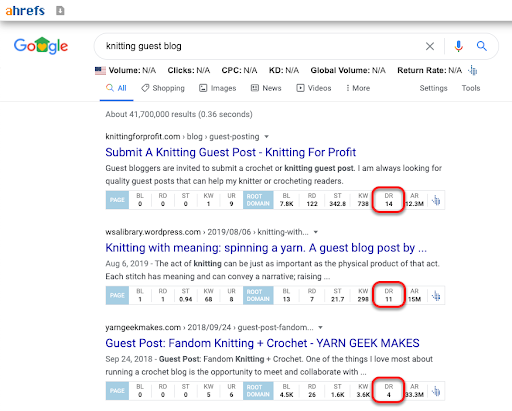
Writing blog posts that will get accepted to high-quality blogs takes time and effort. One trick is called the “evil twin post.” That’s taking a blog post from your own website and writing it from a reverse angle.
“Five Ways to Nail That Job Interview” becomes “Five Things That Will Sink Your Next Job Interview.” Just turn “1. Dress for Success,” into “1. Show Up in Sweats.” And so on.
Get booked on relevant podcasts. Blog posts take a long time to research, write, and polish. A more time effective method might be to get booked as a guest on relevant podcasts. Just make sure that the podcast has a show notes page where they can create a link back to your business.
To find appropriate podcasts, you can search Apple Podcasts or other podcasting platforms for your topic. Look for podcasts that have guests, visit their websites, and use the contact form to reach out.

Find the sites that are linking to your competitors and approach them. If businesses or organizations link to your competitors’ sites, it’s likely they’re open to linking to yours as well…assuming you have valuable content to share.
This is key; if they’re linking to your competitor because your competitor has a detailed blog post on how to tighten an inclined food-grade conveyor belt with an embedded video that shows a breakdown of all the steps and the tools someone needs for the job, and your site simply states you have conveyor belts, don’t expect that link.
How do you know who’s linking to your competitors? Moz has a powerful tool called Link Explorer that allows you to see who’s linking to any website…yours or your competitors.
In this case, drop your competitor’s domain into Link Explorer and you can find out who’s linking to them.

You can see the linking domain, the linking page, the anchor text (what words are linked), the Page Authority, the Domain Authority (similar to the Domain Ranking), and more. This becomes a short list of websites you can approach looking for links.
By the way, this is a freemium tool, meaning that Moz will provide a little bit of information for free, but for more sites you’ll have to upgrade to their paid account.
Create link-worthy content. This one is tough. How do you know what other people will find so valuable that they're willing to take the time to link to it? If you're in the B2B world, don't overthink it. Jeffrey Kranz has already done that for you.

When you’re writing an authoritative article, you cite your sources—and you're not alone. So if you want more backlinks, become a source that other writers want to cite.
One way to do this is by publishing a list of statistics on a topic that your audience wants to know more about. You can pull statistics from separate sources, or if you really want to go the extra mile, conduct some original research with your customers and proprietary data. That's the stuff that writers will link to again and again.
Fundera is one of my favorite examples of this. Four of the six most linked-to pages on their site are lists of stats!
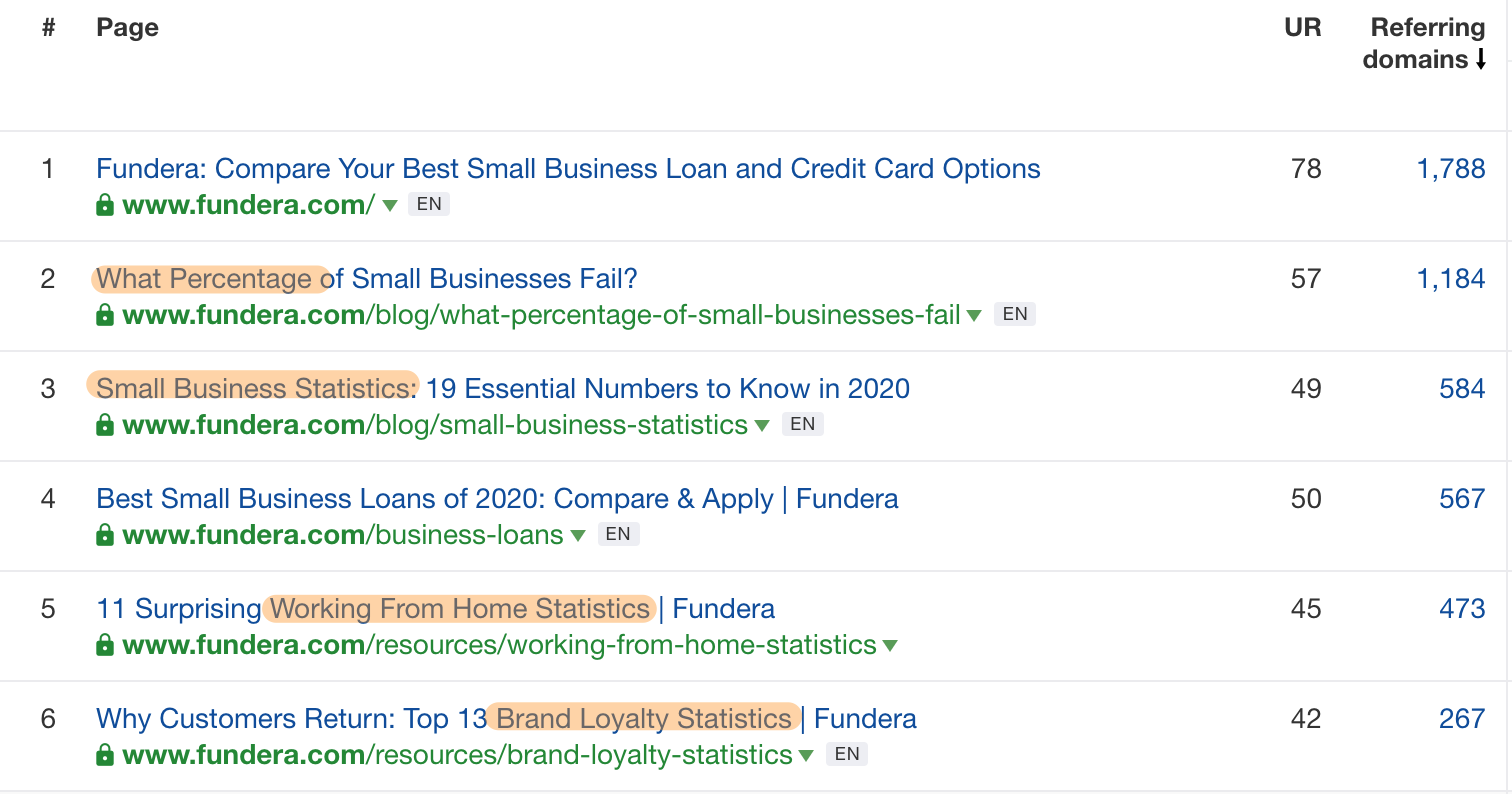
Do a little “digital sleuthing” to connect with digital gatekeepers. Sometimes, getting the attention of a webmaster when you’re looking for links takes a little extra work. After all, many webmasters get requests for links multiple times a day. In an interview with Jason White on our Agents of Change podcast, he shared his technique of “digital sleuthing.”
As he mentions later in the interview, it’s not the most scalable solution ever, but when you absolutely, positively need that link, it could help.
Build authority by becoming an authority. Or, at least by having authoritative content creators write for you. Because backlinks aren’t the only way Google judges authority.

Google wants to surface high quality content in their algorithm, and one way they can confirm content is high quality is by making sure the source behind the content, whether it be the author or the website itself, has the right expertise, authority, and trust to be publishing such content.
Think about it… you wouldn’t want a freelance SEO copywriter with no experience in the medical field providing information on a reputable website for how to treat a disease or ailment, would you? But there aren’t really algorithms that can do that.
So instead, Google hires human raters across the globe to ensure that content that surfaces after their algorithm updates are the most reputable and trustworthy sources. This is referenced as E-A-T, expertise, authority, and trust.
Make sure each piece of content you publish has an expert and authoritative name and credentials behind it, and take the time to build out author biography pages that highlight awards, recognitions, or experience.
Perform "name search" research in Google Search for your content contributors to make sure they show up in other reputable publications, because it's something the quality raters are looking out for.
It's hard to "fake" authority, so if you're starting out from scratch, you can start by guest posting on your industry's popular websites, get involved by speaking at conferences, check for awards and recognitions in your industry and apply for them, and even publish a book or an ebook to help boost your online presence and grow your backlinks to help increase your authority.
7. You Didn’t Optimize Your Business for Local Search
If you have a local business–you serve people in a physical location or service a geographic area–then you’ll want Google to place you in the Local Pack.
[image]
Optimizing your business for local search is different than optimizing your website for organic search, but there are overlaps.
Much of the work is in making sure your NAP info–Name, Address, Phone Number–is identical across online local directories, getting positive reviews, and maxing out your Google My Business listing.
But there are some things you can do on your site to improve your chances of appearing in the Local Pack.
- Optimize your site for your location(s). If you have just one location, work that into your copy. Include your physical address on the bottom of every page. Embed an Google map on your contact and/or directions page. Consider adding it to the footer on every page. Use a local phone number, not an 800 number.
- Create a page for each location. If you own three ice cream parlors in three different locations, give each its own page. Optimize each page with location specific titles, headers, photos, hours, address, directions, nearby businesses and attractions, and so on. Include an embedded Google map.
- Go after local links. Just like in organic SEO, you’ll want to get relevant links, and in this case, that means links from nearby businesses, guides, and organizations.

- Claim your business' Google My Business (GMB) page and update it with all of the info Google suggests, particularly the category and photos
- Link your GMB page to the most relevant URL on your website (e.g. if you are trying to rank for "pizza in seattle" link to your "pizza in seattle" page)
- Get customers to review your business on Google and other review platforms that rank well in Google for your target searches. For example, if you are a local hotel, you'd probably want to get some reviews on TripAdvisor. If you are a restaurant, you'd want reviews on Yelp. If you are an event planner, you'd probably want a listing on The Vendry's virtual events page
- Make sure your site is "mobile friendly" (e.g. loads fast and looks good on a phone)
- For extra credit, create a weekly Google My Business Post. They take about 1 minute to create and can often help attract clicks from people already searching for your brand.
There are plenty of other tactics you will want to employ, but these are some of the most important, and easiest, to get started with.
8. Your Competition is Simply Beating You
No one wants to hear this, but sometimes you just don’t deserve to be the first result…or even appear on the home page.
If you simply list all your products on a page, and your competitor, with similar offerings, has category pages, pages for each product, measuring charts, how-to videos, and so on…well, they should rank higher than you!
If this is the case, then it’s time to do some competitive research.
Go to Google and see who’s beating you for your desired keywords. Not just your real world competition, but the sites keeping you from the top of Google’s results.
If you use a tool like Ahrefs you can then see what keywords your competitors are ranking for, and which pages are optimized for that search term. Visiting those pages will give you a sense of what you’re up against.
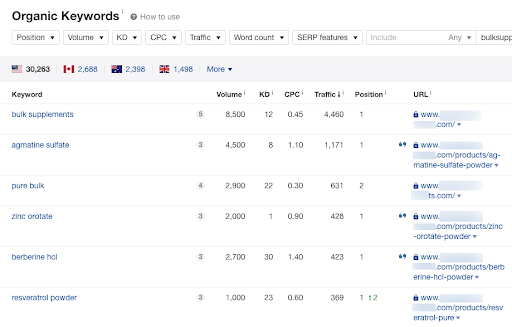
You can also use Ahrefs Content Explorer to see what type of content they’re creating.
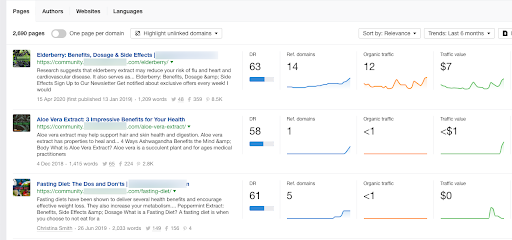
You don’t want to copy your competitors, you want to beat them. Look at the content that’s outranking you on their sites, and see how you can make it better, deeper, clearer, and more valuable.

Let's say you've already covered the basics. Your page and content on it is relevant for the keyword you are targeting. Your site has one of the highest domain authority's and you are authoritative in your niche. But it's STILL not ranking?
Frustrating right?
Well, it might be because your article is not (what I call) "topically complete". For instance, a topically complete article about New York City likely should mention Central Park, The Empire State Building, etc.
You can find topic gaps in your content by trying a tool like the TF-IDF tool. (Note: TF-IDF is not a ranking factor but it is helpful for analyzing content!)
Plug in the keyword you want to rank for and either your URL or paste in your content. The tool is going to tell your 1,2 and 3 word phrases NOT in your content but present in the content of the top 20 results in Google. Do NOT just blindly stuff these into your content, but scan them looking for any that represents a missing topic in your article, and then make sure to update your article to include this topic. The update could be a sentence, a section or anything in between.
You can do the above manually (and for free) by reading through every article ranking in Google for your keyword too, but sometimes a tool is worth the time saved!
What’s Next?
The purpose of this post was to help you uncover why your website doesn’t show up in Google.
Is it a technical problem, like the age of the site or a crawl issue?
Is it an on-page issue, that requires keyword research and unique pages for each offering?
Is it a matter of trust and authority, and you need more inbound links?
Is it that your competitor’s site is just better than yours?
Or, is it a combination of a few of these items?
Hopefully, this post has given you guidance on the changes you need to make to your own site to improve your search rankings, visibility, and traffic.
If you’re feeling overwhelmed, or don’t know where to begin, we can help. Reach out today and we’ll help you get to the top of Google first page.
